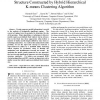23 search results - page 2 / 5 » MEME: discovering and analyzing DNA and protein sequence mot... |
TCBB
2008
13 years 5 months ago
2008
The problem of discovering novel motifs of binding sites is important to the understanding of gene regulatory networks. Motifs are generally represented by matrices (PWM or PSSM) o...
IMSCCS
2006
IEEE
13 years 11 months ago
2006
IEEE
Background: Hydrophobins are fungal proteins that can turn into amphipathic membranes at hydrophilic/hydrophobic interfaces by self-assembly. The assemblages by Class I hydrophobi...
BIBM
2008
IEEE
14 years 2 days ago
2008
IEEE
— Protein sequence motifs information is crucial to the analysis of biologically significant regions. The conserved regions have the potential to determine the role of the protei...
ALMOB
2006
13 years 5 months ago
2006
Background: Discovering approximately repeated patterns, or motifs, in biological sequences is an important and widely-studied problem in computational molecular biology. Most fre...
EVOW
2004
Springer
13 years 9 months ago
2004
Springer
A number of bioinformatics tools use regular expression (RE) matching to locate protein or DNA sequence motifs that have been discovered by researchers in the laboratory. For exam...

